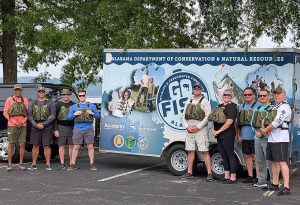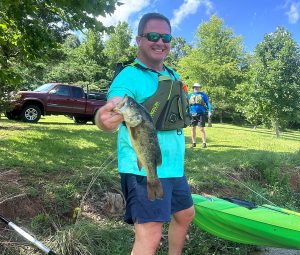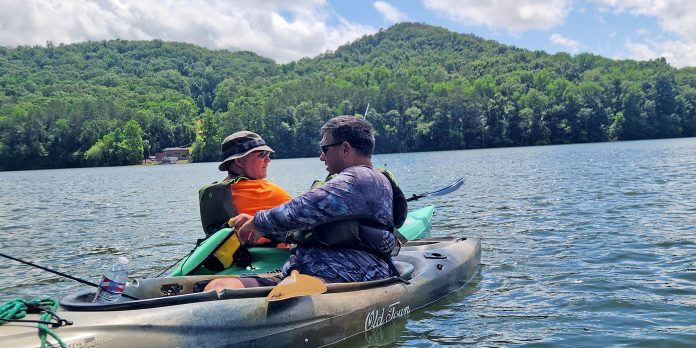GUNTERSVILLE — Staff members from the Alabama Department of Conservation and Natural Resources’ Wildlife and Freshwater Fisheries and State Parks divisions are newly certified instructors in one of the fastest-rising activities on our abundant waterways — paddle sports.
With funding from the Alabama Conservation and Natural Resources Foundation, including donations from Academy Sports + Outdoors, Andrea White of Georgia Rivers was enlisted to teach the American Canoe Association Instructor Certification Workshop at Lake Guntersville.
WFF Conservation Enforcement Officer Vance Wood was among nine participants – seven Conservation Enforcement Officers and two State Parks rangers. Six other participants came from Tennessee and Georgia. Wood applauded the training that will allow the Conservation Enforcement Officers and State Parks rangers to do their jobs more effectively.

“We needed training for our officers,” Wood said. “Our officers are authorized in the use of and utilize power craft in certain areas, but paddle craft usage in the state of Alabama has grown. More and more people are paddling on rivers like the Cahaba, the Coosa, the Tallapoosa, the Flint and Elk. Our officers will benefit from the certification when patrolling those areas to protect the resources and the people who are paddling.
“More people are also becoming interested in kayak fishing. People may be new to fishing or new to kayaking, and they want to try to incorporate those together. We saw this new certification as a way to perform outreach and take our basic fishing instruction (www.outdooralabama.com/
Bill Freeman doubles as an enforcement officer and a member of the Conservation Department’s R3 (Recruitment, Retention, Reactivation) team. He is also in charge of the Department’s Campus Conservation Program. He said the paddle sports training increases opportunities for the department’s R3 efforts.
“As far as our educational programs, it’s going to open a whole new audience for us,” Freeman said. “It’s something we can teach and use to engage a whole different group in outdoor recreation. It will impact us in a huge way.
“The training showed us how important it is for an agency to focus on safety. It’s a great sport, and paddle sports are growing. We can teach safety, how to have a good time and make sure you come home at the end of the day.”
The completion of the course allows the Conservation officers and State Parks rangers to teach paddling techniques and safety to other Conservation personnel and the public.
“The training focuses on safety first and foremost,” Wood said. “Then it covers paddling techniques and how to become more comfortable in a paddle craft. It also covers the differences between the locations you’re going to paddle in, including flat water and moving water.”
Wood said gear selection is a critical piece of the equation to ensure an enjoyable, safe paddling trip. He said the gear needs to match the kind of paddling planned. That is especially true for your personal flotation device. He recommends seeking professional or expert advice in the purchases of life jackets and kayaks.

“Obviously, you should always wear your life jacket,” Wood said. “Try to purchase your kayak and gear from places that can give you sound advice. If you’re going to paddle rapids, you need a certain kayak. If you use a $200 kayak, you are more than likely going to have trouble.”
Wood does not recommend inflatable life jackets for paddling.
“There are several issues with inflatables,” he said. “One issue is if you hit your head and it doesn’t automatically inflate, you won’t be able to inflate it manually. If you get knocked out, you’re just out of the game.
“If you use a Type III life jacket that is suitable for whitewater or kayak angling, choose one that’s comfortable and don’t buy anything cheap. You want something with quality stitching that won’t come apart as easily as the less expensive ones. You’ll need to spend a little extra money on your life jacket, but it’s worth it.”
Wood said that, according to the latest U.S. Coast Guard statistics, the number of paddling fatalities has gone up nationally as the popularity of the sport has increased. He considers kayak anglers to be more vulnerable than paddlers who often travel in groups, but he encourages anglers to try fishing from a kayak.
“Get a fishing license and start fishing from a paddle craft,” he said. “This is a great way to get out on the water and enjoy fishing. It’s safe if you follow paddle sport safety, and you can fish in waters that are not accessible to other vessels. You can fish in places where a bass boat can’t go. But when you’re out there fishing, you may not easily be seen by other boaters. I recommend a bright colored paddle craft and clothes to make sure you will be seen on the water.
“It’s also important to create a float plan. Let somebody know where you’re going, where you’re planning to take out and what time to expect you at home. If you don’t make it to the take-out, lose your phone, and you’re stranded out on a rock, they have better information to provide to first responders to help them find you quickly.”
The participants also took the opportunity to practice rollovers and exiting and reentering their kayaks, which can be especially difficult for kayak anglers.
“It’s more difficult than you think,” Wood said. “That’s one thing I think people don’t practice enough – getting back on their craft after they’ve rolled out. When you put a fishing kayak into the equation, a lot of people have fish finders and other equipment mounted on their paddle craft. If you have that craft trimmed out and take a spill, you have all that gear to get around to get back in the kayak. In open water that is very difficult. There are techniques we can teach on how to right your boat, but it’s a lot harder with all that gear. The main thing is to stay calm. A lot of people tend to panic, and that can cause problems.
“Paddling is a fun activity for the entire family, but safety is paramount.”
Andrea White of Georgia Rivers admitted she put the participants through the wringer.
“We covered it all from the Level 1 kayak curriculum for lakes and sheltered water,” White said. “We covered our Level 2 curriculum for Class I rivers. We covered kayak fishing, including specifically with the hazardous gear and considerations for kayak anglers. We included some rescue training on Class I and Class II rivers on how to get across a strong current to help somebody.”
White said many people think paddling is a straightforward activity, just launching and paddling away, but there is so much more to learn for a safe, enjoyable trip.
“We want to help people prevent accidents and come home happy,” she said. “We taught good paddling techniques and rescue techniques, how to deal with dam releases, water levels and water temperatures. We also taught the five moving-water skills so you have better boat control in current. The rollovers weren’t part of this curriculum, but when you get a group of guys so fired up, they want to try everything.
“I think this training was successful in a number of ways. I think it was successful for the state of Alabama, who was gracious enough to give us the critical mass to start this. I think it was a success for the people from Georgia and Tennessee who came to be able to train with the folks from Alabama.
“I also think it was a success in helping us roll out the American Canoe Association’s instructor credentialing and kayak fishing curriculum to attain safety goals among kayak anglers across the country. I really feel we hit a really big multiplier effect with this group.”
Don’t miss out! Subscribe to our email newsletter to have all our smart stories delivered to your inbox.



